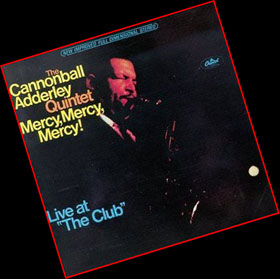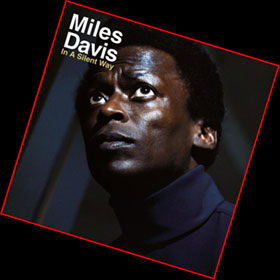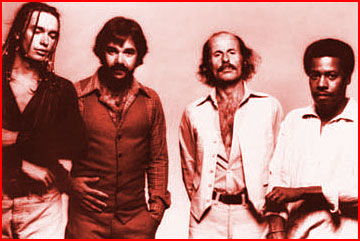
|
|||
|
|||
| Home |
| Gallery |
| Culture/ Technology |
| Fiction |
| Music |
| Poetry |
| Theater |
| What's New |
| About/Contact |
| Archive |
|
Viennese mambo Published Nov. 25, 2007 The summer of '69 was pickup ballgames on dusty diamonds amid the green, rolling hills of northern Maryland, trips to B-more for Hoagies and crab cakes, fervent discussions on the O's prospects, mysterious pornographic apocrypha and black and white images of beings in boxy, glistening suits stumbling about a lunar landscape. Then there were the ever-present sonic reverberations: hanging out with cuz Stevie at Angelo's gigs with little Leroi from PA on drums destroying "In-A-Gadda-Da-Vida" or mellowing everybody out with his silky crooning on "My Girl," cruising the two-lanes in Larry Lamb's Camaro with his 8-track wailing Zeppelin, and Hendrix was all the rage with Credence coming on strong in the daily afternoon record jams. And then there was "Mercy, Mercy, Mercy" – my contribution to the session, a little bit of soul food for the banquet. True, "Mercy" had been out for quite a while and the title track had made all the airwaves and even made the Top 40 rotation, but I had just copped the album, one of maybe five in this 15-year-old fledgling jazz fan's collection.
This was my intro to the musical world of Josef Zawinul, and he has never ceased to occupy a prime place in my musical consciousness. As with so many of the great ones in recent years, the wondrous Zawinul split the scene from this sphere on Sept. 11, and is henceforth engaged in infinitely swinging celestial jam sessions. More than the critics knew at the time it was release in 1966, "Mercy" was a breakout album for Zawinul and a prophecy of things to come. While on the rest of the album, he placed acoustic, on "Mercy" he played the electric piano. The Fender Rhodes had a presence that was at once subdued and brooding, yet warmly encompassing. Unlike the other tunes that feature Cannonball and Nat soloing on their horns, they only state the theme and some accompaniment riffs, while Zawinul plays a rich, understated solo with the emphasis on soulfulness. Though the Fender had been popular in rock and R&B, it was still unusual in jazz at the time of this recording – but more important was the striking way in which he used it. In a rare reversal of the relationship between jazz and pop, a rock group, The Buckinghams, covered it. Both the sculpted electronic sound and the emphasis on structure and texture rather than extended improvisation foreshadowed the direction in which Zawinul was heading. He would write a couple more soul anthems with Cannonball, including the stirring spiritual "Country Preacher," dedicated to the Rev. Jesse Jackson. What astonished many was that the composer of "Mercy" was not someone whose roots were in the African-American south or the black urban ghettos, but instead a cat born on the mean streets of Vienna. Zawinul said he grew up in a relatively poor family, not among Vienna's storied elite, but did benefit from a culturally mixed middle- and Eastern European background. While it was quite surprising to many American musicians that an Austrian dude could produce such soulful work, in reality Zawinul paid some serious dues. After receiving classical training in Vienna, he attended the Berklee College of Music in Boston and soon was working with Dinah Washington and Maynard Ferguson, among others, before hooking up with Cannonball. He was, as he intimated in interviews about his past, an honorary brother of the highest order.
While an erstwhile musical accomplice, Zawinul only worked with Miles in the studio. As Miles reportedly said, if he'd brought Joe into the band, pretty soon it would be his band and Miles' modus operandi was always to be the boss. Besides, Zawinul had his own direction, an approach that led to the formation of Weather Report, in collaboration with Miles' saxophonist, Wayne Shorter, who had written most of the themes performed by the Davis group in the mid-to-late '60s, and was as much a student of form as Zawinul. Both were after a more structured approach than Miles was pursuing, though early"Weather Report as manifested by the eponymously named first album and the second album, "I Sing the Body Electric," had plenty of wooly moments flirting with the avant-garde. The format of the group was the same throughout its tenure until the band broke up in the mid-1980s: Zawinul on multitudinous keyboards, Shorter on tenor and soprano saxophones, plus a bassist, Afro-Brazilian-Latin percussionist and a drummer, always of the funky variety. Central to the concept – as consciously alluded to in the group's name choice – was the emphasis on diverse sounds, both electronically and acoustically, through highly improvisational percussionists, including Airto and Dom Um Romao, that were like ambient sonic reports. But along with that, the band wanted to groove with tight but complex cross-rhythms that made people move and a forceful, funky bass line moved forward in the mix. The original bassist, Miroslav Vitous, actually played an amplified upright, and while extremely talented and versatile, he was ambivalent, as his playing would sometimes suggest, about the funky direction the band was heading in, as evidenced by the release in the early '70s of "Sweetnighter." Though panned by many critics as a sell-out, it was both artistically engaging and popular, featuring Zawinul's kaleidoscopic electronic escapades, Shorter's incisive commentary, and popping funk rhythms that were in fact highly danceable. The album also featured some exquisitely beautiful tone poems brilliantly orchestrated by Zawinul. This album also highlights the group's fascination with complex cross-rhythms and textural layering, components that would distinguish Weather Report and elevate their music to a high level. The band really hit its stride with Alphonso Johnson on bass and Victor Bailey, later to be eclipsed by bass guitar avatar Jaco Pastorius, who propelled the group to new levels.
By the late 70s, Weather Report had achieved a celebrity akin to rock bands, and they would regularly fill concert halls and arenas. Just about any Weather Report album – "Mysterious Traveler," "Tale Spinnin'," "Heavy Weather" and "Procession," to name some – had something enthralling to offer and they sound as fresh and modern today, though not as revolutionary from the single fact that the group introduced a lot of sounds and ideas that were emulated by many keyboardists and fusion groups. Yet, sadly, except among a handful of jazz enthusiasts and admirers left over from the generation weaned on Weather Report, the group has largely been forgotten, relics from the bygone era of 33 1/3 LPs. A latter-day triumph in his career was captured on CD with the recently released "Brown Street," recorded at Zawinul's club, Birdland, in Vienna, in October 2005, on which he performs some of his best compositions played by Weather Report with ex-bandmates bassist Bailey and percussionist Alex Acuna, plus drummer Nathaniel Townsley and WDR Big Band. Cuts such as the title piece, "Fast City," Badia/Boogie Woogie Waltz," "Procession" and "Carnavalito" recapture the excitement of Weather Report, propelled by Zawinul, whom I can readily envision with his intense gaze, head adorned with his African woven skullcap, bobbing above banks of equipment, hands darting among his various keyboards and control panels weaving dreams and spinning tales ... Mercy ... Mercy ... Mercy. |
Copyright ©
Reprinted by permission of author, who retains all copyright and control.

 The bulk of the album, recorded with a live audience, consisted of Cannonball's and brother Julian's soul-bop compositions and propulsive soloing, but "Mercy" (at the end of the first side) stood in startling contrast – a slow gospel groove introduced with a contemplative rap by Cannonball about the nature of "adversity" that wound up like this: "... And I have advice for all of us. I got it from my pianist, Joe Zawinul, who wrote this tune and it sounds like what you're supposed to say when you have that kind of problem. It's called 'Mercy ... Mercy ... Mercy.' "
The bulk of the album, recorded with a live audience, consisted of Cannonball's and brother Julian's soul-bop compositions and propulsive soloing, but "Mercy" (at the end of the first side) stood in startling contrast – a slow gospel groove introduced with a contemplative rap by Cannonball about the nature of "adversity" that wound up like this: "... And I have advice for all of us. I got it from my pianist, Joe Zawinul, who wrote this tune and it sounds like what you're supposed to say when you have that kind of problem. It's called 'Mercy ... Mercy ... Mercy.' " Not surprisingly, Zawinul's interest in electronic music and his compositional conception led him by the late '60s to an association with Cannonball's former boss, Miles Davis, who had been moving in a similar direction as Zawinul in experimenting with rock back beats merged with Afro-Caribbean polyrhythms and shunning the traditional 32-bar song form in favor of circular themes and modal improvisation. Indeed, Zawinul fueled much of Miles' success in his "New Directions" phase, contributing the shimmering title composition of the album
Not surprisingly, Zawinul's interest in electronic music and his compositional conception led him by the late '60s to an association with Cannonball's former boss, Miles Davis, who had been moving in a similar direction as Zawinul in experimenting with rock back beats merged with Afro-Caribbean polyrhythms and shunning the traditional 32-bar song form in favor of circular themes and modal improvisation. Indeed, Zawinul fueled much of Miles' success in his "New Directions" phase, contributing the shimmering title composition of the album 